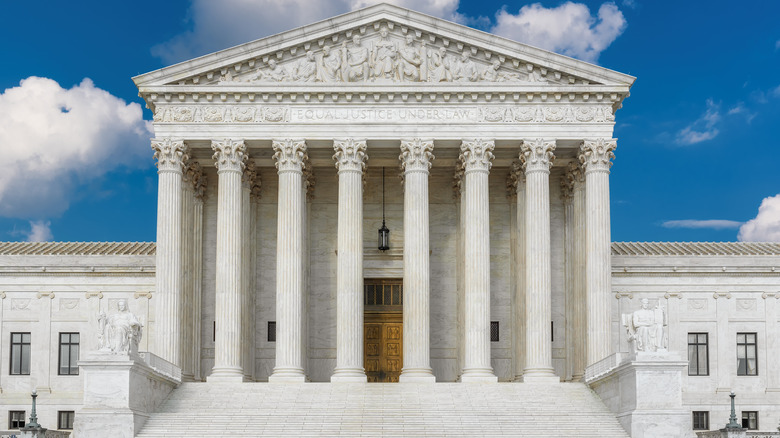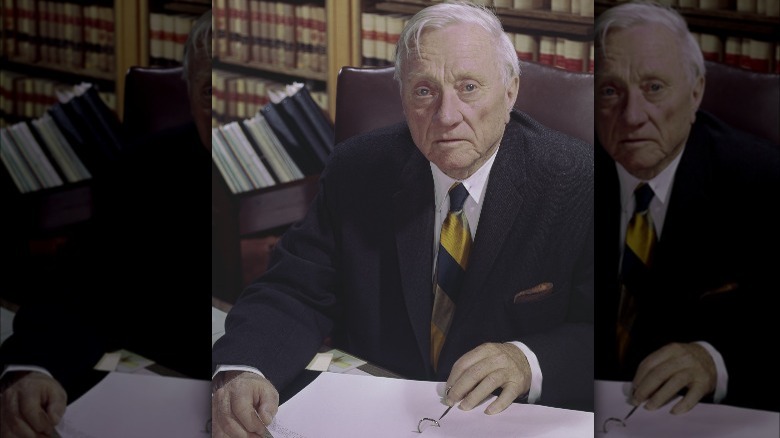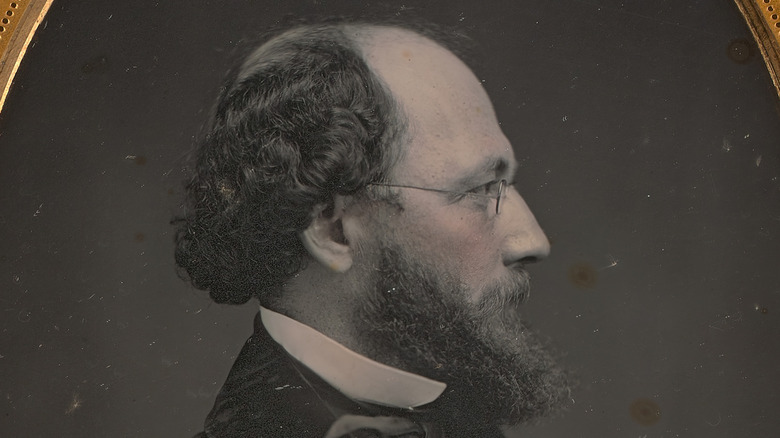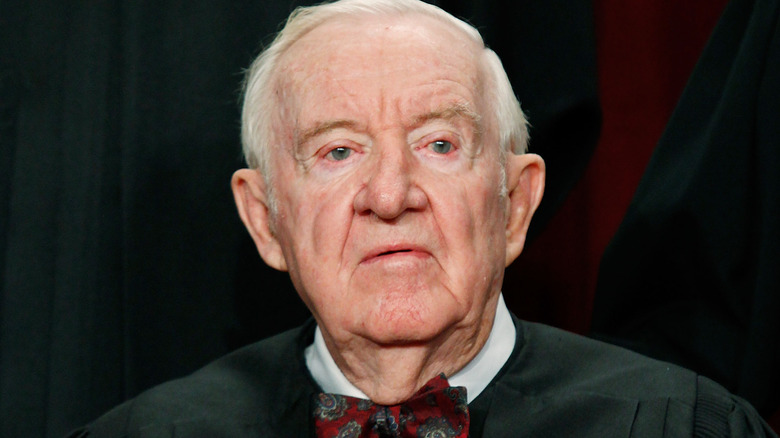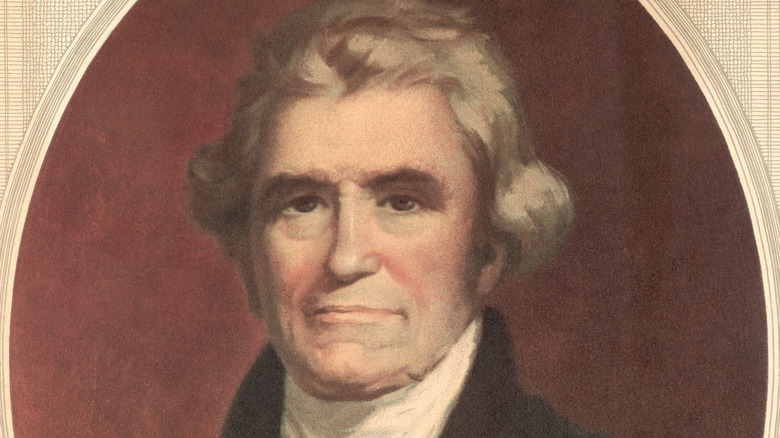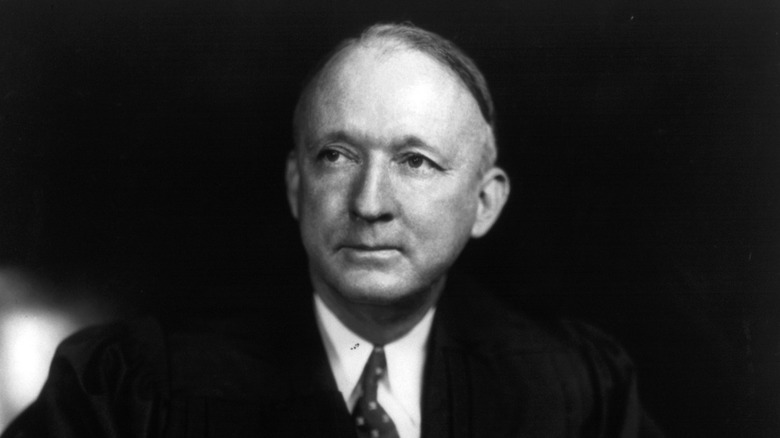These Are The Longest-Tenured Supreme Court Justices
The United States Constitution (posted at the National Archives) lays out the various ways in which each of the three branches of government — legislative, executive, and judicial — each assert their power. Further, the document lays out how the individuals who fulfill various roles in each of those branches are elected and/or appointed. It's all part of the checks and balances written into the Constitution, which are intended to keep one branch from having too much power.
Supreme Court justices serve for life, according to the Constitution. And as a 2010 article in Demography notes (posted at the National Library of Medicine), of the dozens of men and women who have served on the Court over the centuries, 44.5% of them have died in office, and 47.3% retired from the bench before they died. Some of the justices have served for decades, others less than a couple of years. These are the five longest-tenured Supreme Court justices.
William O. Douglas served 36 years, 209 days
William Orville Douglas was born in Minnesota, according to Britannica. His father, a Presbyterian minister, died when William was a child, and William himself contracted polio at a young age. However, through self-imposed regimen of fresh air and outdoor exercise, he survived, and in the process, developed a fondness for the outdoors. After a career of practicing and teaching law, Douglas was nominated for the bench by President Franklin Delano Roosevelt in 1940. Douglas was only 40 years old, making him one of the youngest SCOTUS justices to ever serve.
During his tenure on the Court, Douglas strongly advocated for liberal causes, sometimes controversially so, according to the First Amendment Encyclopedia. In one of his more controversial opinions, for example, he advocated against the death penalty imposed on Julius and Ethel Rosenberg, a couple convicted of selling American nuclear secrets to the Soviets. On November 12, 1975, Douglas, now comfortably in his 70s and having previously suffered a stroke, retired, after nearly four decades on the Supreme Court.
Stephen Johnson Field served 34 years, 195 days
Stephen Johnson Field was born in Connecticut in 1816, according to Britannica. He practiced law for a while, served in the California state legislature, and eventually made his way to the Supreme Court, appointed by President Abraham Lincoln in 1863. One key piece of Field's history on the Supreme Court was his legacy as it relates to government intervention in business practices. As Supreme Court Collection notes, he steadfastly opposed state or federal governments interfering in business. This "hands-off" attitude would prevail until the 1930s, when progressives helped bring about such things as the five-day work week, the 40-hour work week, the end of child labor, and so on.
Field also controversially (for his time) penned majority opinions in cases that struck down laws that required applicants to take an oath to the Union (this was during the post-Civil War Reconstruction era) as a condition of employment. Field retired on December 1, 1897, and died two years later.
John Paul Stevens served 34 years, 192 days
John Paul Stevens was born in Illinois in 1920, according to Britannica. He served in the Navy during World War II, and then went into law, where he practiced in various capacities until 1975, when President Gerald Ford nominated him to the Supreme Court. Though Ford appointed him to the court with the hope that he would be a conservative hedge against the court's liberal makeup of the time, Stevens was actually mostly independent and, at times, somewhat liberal.
For example, in District of Columbia v. Heller, Stevens wrote for the dissenting minority, indicating that he and his colleagues did not believe that the 2nd Amendment gave individuals the right to own handgun. "Guns are used to hunt, for self-defense, to commit crimes, for sporting activities, and to perform military duties. The Second Amendment plainly does not protect the right to use a gun to rob a bank," he wrote, via Cornell Law School. Stevens retired in 2010, and died nine years later, at the age of 99.
John Mashall served 34 years, 152 days
The only man on this list to have served as Chief Justice, John Marshall was born in 1755 in Virginia (per Britannica). In what has become a cliche when it comes to presidents, Marshall was born in a log cabin, although he was hardly poor. He served in the Continental Army during the Revolutionary War and, afterwards, got his law license and went into politics. He was appointed to the Supreme Court by President John Adams in 1801.
Marshall's most famous legal opinion comes from what is probably one of the most important cases to ever appear before the Supreme Court: Marbury v. Madison, the case in which the Court granted itself the power of judicial review. Writing for the majority, Marshall wrote that, "The Constitution is either a superior, paramount law, unchangeable by ordinary means, or it is on a level with ordinary legislative acts, and like other acts, is alterable when the legislature shall please to alter it" (via Cornell Law School). Marshall died on July 6, 1835, while still serving on the Supreme Court.
Hugo Black served 34 years, 29 days
Hugo Black was born in Alabama in 1886, according to Britannica. After getting his law degree, he practiced for a while in Alabama, often representing the under-represented, such as Blacks or striking laborers. Like William O. Douglas, Black was appointed by President Franklin Delano Roosevelt. In his decades on the bench, according to the First Amendment Encyclopedia, Black was a steadfast advocate for the idea that the 14th Amendment meant that the same limitations placed on the federal government by the Constitution were intended for the states as well. In other words, the First Amendment says that the federal government cannot punish you for the words you speak or write (within certain parameters), and the 14th Amendment means that the same is true of the state in which you live.
Black suffered a serious stroke in 1971, according to The New York Times, and promptly retired. He died two days later, at the age of 85.
